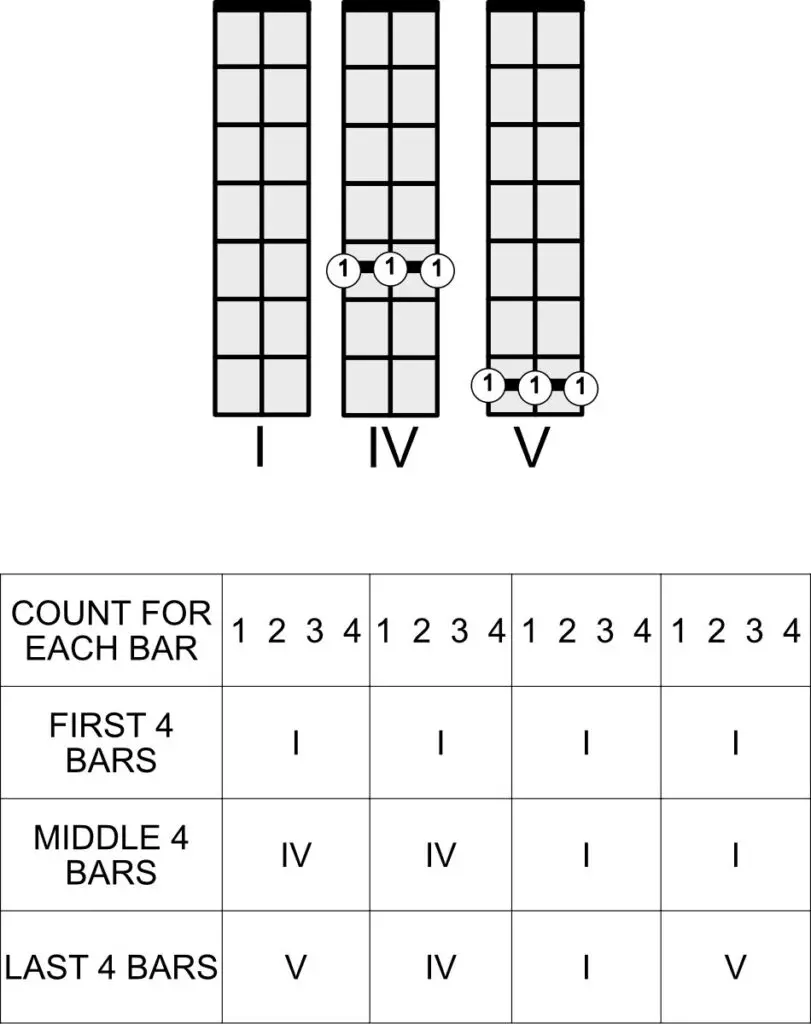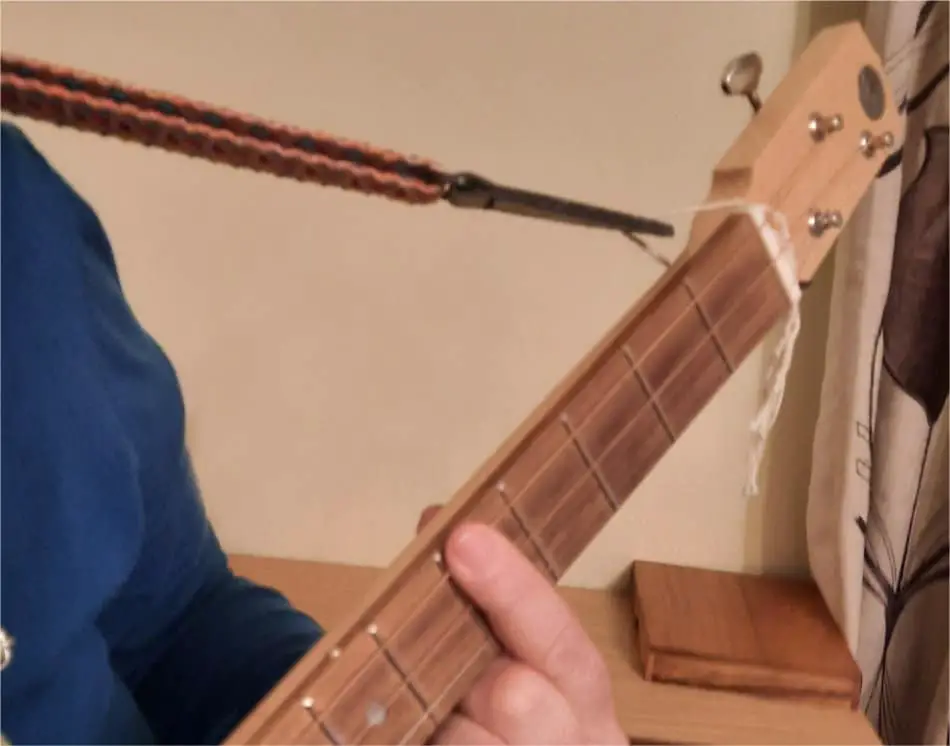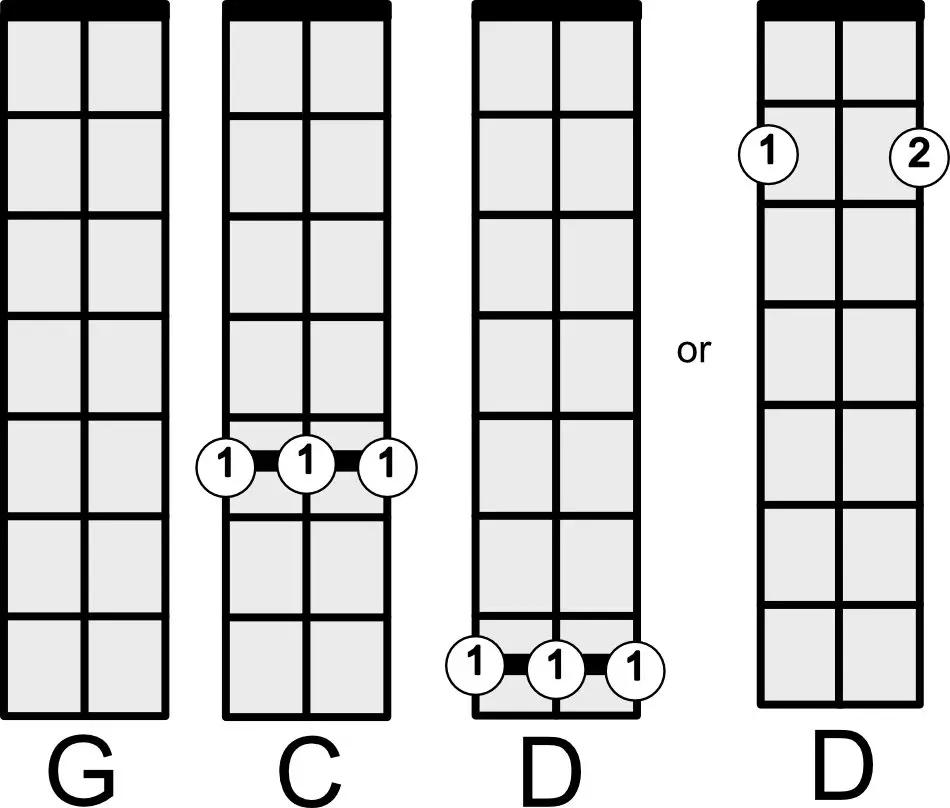Whether you’ve built or bought your cigar box guitar, one of the first questions you will ask yourself is “What can I play as an absolute beginner on cigar box guitar?“
This is a very easy 12 bar blues progression that will teach you three chords and how to strum those chords. It is suitable for absolute beginners.

You can play the blues progression with any I, IV and V chords but for this beginner lesson we are using the open strings as the I chord.
As you get more experienced you can add a few changes to make it more interesting.
Check Your Guitar Is In Tune
As long as your guitar is in tune with itself, you don’t really need to tune to particular notes.
The most important thing is to check that when you play the 7th fret of the bass string it sounds the same as the open middle string. When you fret the 5th fret of the middle string it should be the same as the open top string.
- The string nearest the ground is the highest pitched string, often called the top string.
- The string nearest the ceiling is the lowest pitched string, sometimes called the bass string.
- The middle string is middle in position and middle in pitch.
If you are left-handed you might like to check out my Tips For Left-Handed Players Of A Cigar Box Guitar
If you want to tune to the most usual tunings of a 3 string cigar box guitar tune to G D G or E B E. Many other tunings are available as shown in my guide 9 Different Tunings For A Cigar Box Guitar but for now I suggest you stick to either open G or open E:
If you know any music theory at all: The top and bottom string are both tuned G and are an octave apart. The middle string is tuned D and is a fifth above the bass and a fourth below the top string. But the great thing about cigar box guitar is that you don’t need to know any theory at all to start playing music.
How To Hold The Cigar Box Guitar
Sit to play as a beginner. I often like to play with a strap even sitting down but you don’t have to. However later on you may want to get a strap and stand to play but I think it’s easier to start by sitting down.
Hold the guitar comfortably, with your strumming hand about an inch or two from the end of the fret board and your arm resting comfortably on the box. As you progress, you may want to strum nearer the bridge, but as a beginner strum near to the end of the fretboard.
Place your other hand on the back of the neck so that your forefinger can rest on one of the frets near the nut. Your thumb and forefinger make a squashed letter C shape behind the neck:

Starting To Strum
You can use a pick, your thumb or a finger to strum down. Try these 3 options now to decide what suits you :
Pick- hold the fattest part of the pick between your thumb and pointy finger with the pointed end away from your fingers
Finger- I find it easiest to strum using the whole of my pointy fingernail
Thumb- hold your hand loose so that the fleshy part of your thumb can strum over the strings ( or grow your thumb nail and use that.)
I have more tips for strumming in this guide: Cigar Box Guitar Strumming: 10 Tips For Complete Beginners
To Slide Or Not To Slide?
I find it much easier to fret with my fingers than use a slide, but I know some of you will want to play with a slide so I have written a beginners guide here: How Do You Begin To Play Slide On A Cigar Box Guitar?
The main differences in playing with a slide and using your fingers are:
- the 2 styles sound very different and you will probably have a preference
- the slide needs to sit just on the fret wire ( or fret line of a unfretted guitar)
- your fretting finger needs to sit just behind the fret wire ( see the picture above where I am fretting on the 5th fret)
Learn Your First Three Chords

The I Chord
In open tuning, whatever key you are playing in, strumming the strings without fretting at all gives the I or one chord. In open G this will be a G power chord; In open E this is an E power chord and so on.
This can be written in 2 ways: 0 0 0 refers to the strings ( bass string first) or a chord chart as shown above.
The IV Chord
Fretting at the 5th fret, either with a finger or a slide, gives the IV or 4 chord (IV is 4 in roman numerals) In open G this is a C power chord.
The V Chord
Fretting at the 7th fret gives the V or 5 chord. In the chart above I have given an alternative to this. In open G both of these chords are D power chords.
Before you start putting these chords together in a progression, you need to be able to play them confidently separately:
- Make sure that when you say in your head 1 chord you remember that this is open strings
- The 4 chord is played at the 5th fret
- The 5 chord is played at the 7th fret
I won’t go into the theory here of why the chord numbers and fret numbers don’t match up, just remember the numbers.
Playing The 12 Bar Blues For the First Time
We’ve got the chord shapes sorted so now its time to play the chord progression:

Here is the file for you to download:
- Start slowly- It’s more important to keep things at a steady beat than it is to go fast
- Start by playing just the 1st beat of each bar- this means count 1 2 3 4 I 1 2 3 4 I 1 2 3 4 I 1 2 3 4 and only strum down on the 1 beat
- Play the first line of the 12 bars – This will be 4 strums down of the open notes, counting 2 3 4 in between each strum
- Play the middle 4 bars – This will be 2 strums down of the strings fretted at the 5th fret, followed by 2 strums down of the open notes, counting 2 3 4 in between each strum
- Play the last 4 bars – This will be 1 strum down of the strings fretted at the 7th fret, followed by 1 strum down of the strings fretted at the 5th fret, followed by 1 strum down of the open notes, followed by 1 strum down of the strings fretted at the 7th fret counting 2 3 4 in between each strum
This is s a lot to put together as a beginner, so go slowly and steadily to get this in your head before you add any extra strums.
Learn A Strumming Pattern
- Start by adding down strums on the 2nd and 4th beat of the bar as well as the 1st:
This means count 1 2 3 4 I 1 2 3 4 I 1 2 3 4 I 1 2 3 4 and strum down on the bolded numbers ( say the 3 in your head but don’t strum)
- Play this strumming pattern with the chord progression as shown above.
It’s important to keep your strumming hand going up and down steadily as before. It’s just that when you omit the strum you pass over the strings without strumming them.
- Now try adding up strums. This takes practice. Strum down and up counting 1 and 2 and 3 and 4, playing down strums on the main beats and up strums on the “ands”. This will sound clumsy at first but when you can play this slowly and steadily, try this pattern where D is down strums and U is up strums:

- When you are confident at down and up strums try this pattern where you need to omit some of the strums:

The last pattern is my attempt to put a swing or shuffle rhythm in a table, but music is not quite as even as that. Yes you need to keep the main beat steady ( especially the 1 beat in each bar) but let yourself feel the music for the other beats. They need to swing a bit. I will be doing a YouTube video showing this at some point.
